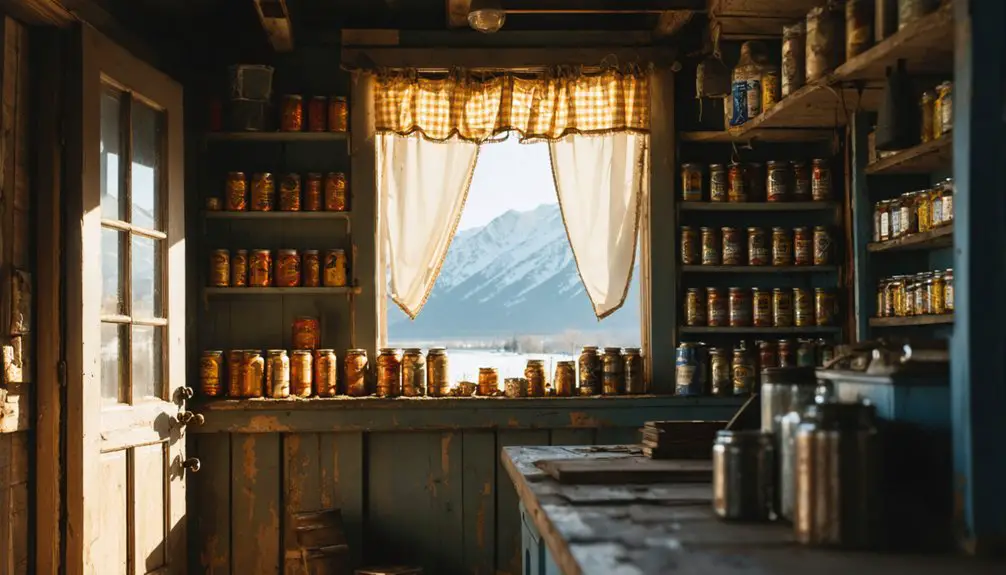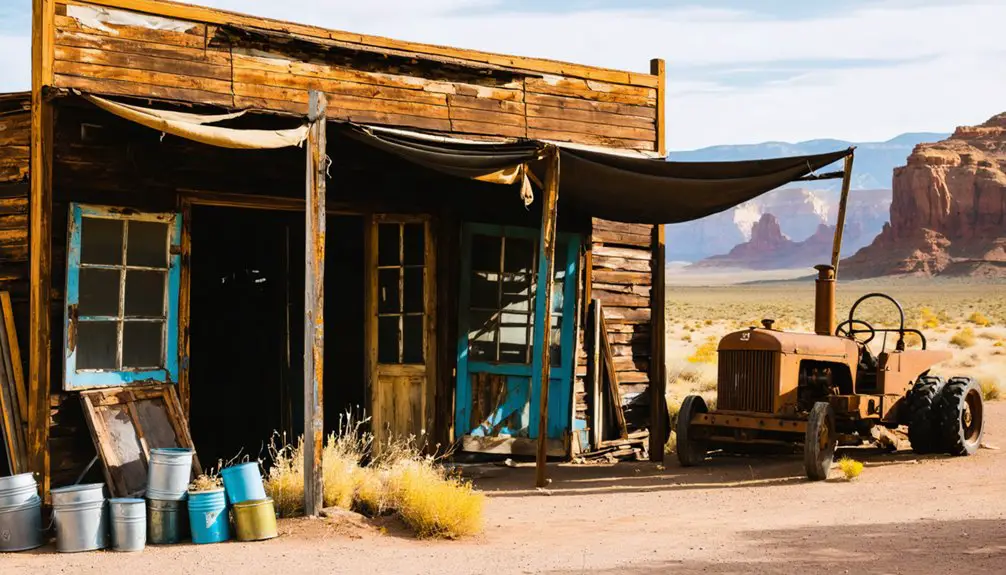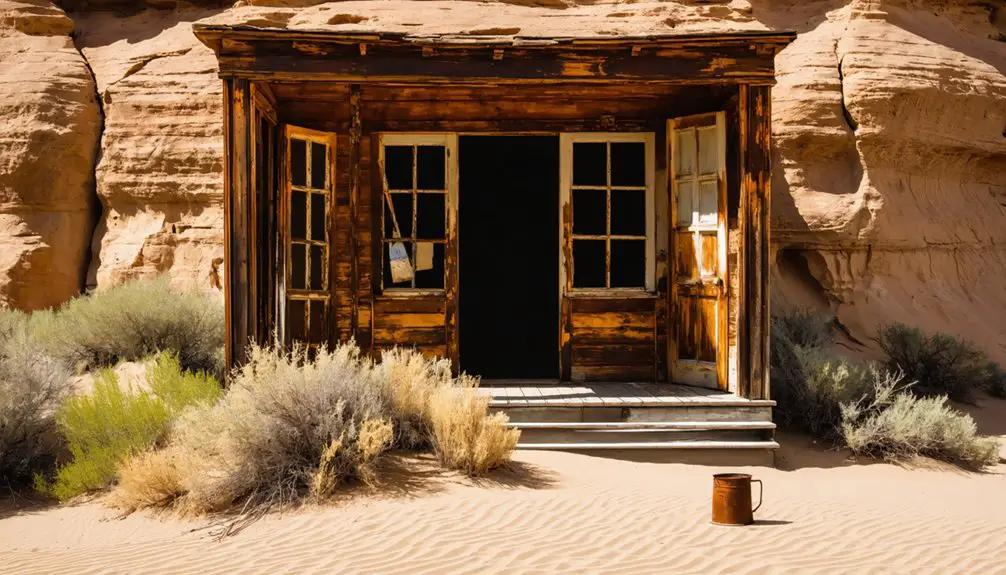You’ll discover Valley City’s haunting remains along Utah’s Jordan River, where ambitious settlers established a farming community in 1905. The settlement thrived briefly with 2,500 acres of farmland and 60 acres of orchards, supported by a dirt dam irrigation system. Water scarcity, flash floods, and soil degradation forced residents to abandon their dreams by the 1930s. Today, weathered foundations and eroded root cellars tell a compelling story of pioneer determination against nature’s might.
Key Takeaways
- Valley City was established in 1905 as a farming settlement with 2,500 acres of farmland and 60 acres of orchards.
- The town’s agricultural success was short-lived due to water scarcity, failing irrigation systems, and soil contamination from uranium mining.
- A devastating flash flood destroyed the vital dirt dam irrigation system, accelerating the town’s decline.
- Residents gradually abandoned the settlement throughout the 1920s and early 1930s due to environmental challenges.
- Today, only scattered ruins remain, including foundations of the hotel, farmhouses, and root cellars.
The Birth of an Agricultural Dream
While Utah’s agricultural expansion in the early 20th century transformed vast tracts of arid land into productive farmland, few areas exemplified this pioneering spirit more than Valley City.
You’ll find that between 1909-1918, settlers claimed an average of 575,000 new acres annually, driven by dreams of agricultural prosperity.
Early water management proved challenging, as you’d have struggled alongside other settlers who relied on wells, springs, and river-hauling.
Agricultural innovations emerged through necessity, with farmers implementing canal systems by the 1880s to divert Jordan River water.
Despite these advances, you’d have faced persistent challenges from alkali deposits and mineral-laden soil.
Like many settlers, you’d have needed multiple income sources to survive while battling poor soil conditions and unreliable water access in your quest for agricultural success.
The Mormon Welfare Program later established agricultural projects near urban centers to maintain connections to farming traditions.
The completion of the Strawberry Reservoir in 1911 marked a turning point for irrigation, providing water to over 42,000 acres of farmland.
Life in Early Valley City
If you’d visited Valley City in its early days, you’d have found a small agricultural community centered around basic dwellings, a schoolhouse, and a distinctive two-story hotel.
Daily life revolved around tending to the orchards and crops, which relied on a precarious irrigation system fed by a dirt dam that frequently suffered flood damage. Like the families in Grafton’s relocation, residents had to adapt to flooding challenges that threatened their livelihood. By 1908, settlers had successfully irrigated sixty acres of orchard using the reservoir’s water.
The town’s social activities centered primarily on the school, where teachers worked through the 1920s and early 1930s, and the hotel, which served as a gathering place for the tight-knit farming community.
Daily Community Activities
Three distinct spheres shaped daily life in Valley City: commerce, social gatherings, and transportation links.
You’d find community life centered around the general store, where locals exchanged news while purchasing essentials. The store stocked both local and imported goods, connecting you to the wider world beyond the settlement. The bustling commercial district served a population of over 300 residents by 1903.
Social gatherings helped forge bonds among miners and settlers, with community celebrations creating a sense of belonging in this rugged landscape. You might’ve attended informal events at saloons or hotels that doubled as meeting spots. The town developed a reputation similar to Frisco, with its 23 saloons attracting both locals and travelers.
Like other frontier towns, Valley City relied on stagecoach connections for crucial communication and supplies. These regular coach arrivals brought mail, goods, and news, keeping you connected despite the town’s remote location.
Agricultural Settlement Challenges
Despite the optimistic visions of early settlers, Valley City’s agricultural endeavors faced devastating environmental challenges that would ultimately contribute to its downfall.
You’d have struggled alongside these determined farmers as they battled constant water scarcity and irrigation struggles. Their makeshift dirt dam, built around 1905, couldn’t reliably sustain the community’s farming needs.
When you weren’t hauling water in barrels, you’d watch helplessly as irrigation brought harmful minerals to the surface, poisoning crops and creating toxic alkali deposits. The soil’s degradation forced many of your neighbors to take on multiple jobs just to survive. The original Joseph and Susanna Harker settlement faced similar challenges when they first crossed the Jordan River in 1848.
By the 1890s, three major canals were constructed to help address irrigation needs, but water remained scarce throughout the region.
Flash floods posed an ever-present threat, and when they finally destroyed the dam, Valley City’s hopes of agricultural sustainability were washed away with it.
School and Hotel Life
Life in Valley City centered around two prominent buildings that shaped daily routines: the schoolhouse and the hotel. You’d find students of all ages gathered in the one-room schoolhouse during the 1920s and early 1930s, where a single teacher managed eight grade levels simultaneously. Similar to Grafton’s experience, the town faced serious challenges from frequent flooding that threatened local infrastructure.
While school challenges included limited resources and deteriorating facilities, the building served as a vital educational hub until flash floods forced families to leave. Ice storage refrigeration remained a necessity until electricity finally arrived in 1947.
The two-story hotel stood as the town’s most impressive structure, where you’d encounter travelers and workers involved in irrigation projects. Though details of its operations remain scarce, the hotel’s presence reflected Valley City’s early aspirations for growth.
Like the school, it eventually succumbed to vacancy as the town’s population dwindled, leaving behind memories of a once-hopeful settlement.
The Dam That Changed Everything
In 1905, ambitious plans for Valley City’s development centered around the Grand Valley Land and Mineral Company’s vision to construct a cement dam that would irrigate 2,500 acres near Thompson, Utah.
Due to financial mismanagement and misuse of investor funds on horse races, you’ll find that developers settled for a dirt dam instead.
After squandering investor money at the racetrack, the developers had to abandon their grand cement plans for a humble dirt dam.
- The dam’s construction initially attracted twenty settlers who planted orchards.
- Torrential rains triggered a devastating flash flood that destroyed the dirt dam.
- Indiana investors lost their investments and most returned home.
- M.L. Burdick and his sons-in-law later rebuilt the dam, briefly reviving agriculture.
While the rebuilt dam enabled some farming to continue, it wasn’t enough to save Valley City.
The dam’s failure marked a turning point, and though irrigation resumed, the town never recovered its early promise, eventually becoming the ghost town you can explore today.
Daily Living and Community Spirit

When Valley City emerged in 1905, you’d find a close-knit farming community centered around a two-story frame hotel and schoolhouse.
You’d witness neighbors working together to manage irrigation systems and tend to roughly 2,500 acres of farmland, including 60 acres of flourishing orchards by 1908.
Community gatherings at the hotel fostered social resilience among the pioneering families. They’d share meals, celebrate harvests, and support each other through the challenges of frontier life.
At the schoolhouse, children learned from a dedicated teacher while their parents collaborated on agricultural tasks and infrastructure maintenance.
Despite recurring floods and economic hardships, Valley City’s residents maintained their spirits through mutual support and shared determination, though ultimately these environmental challenges would force them to abandon their dreams of a permanent settlement.
Environmental Challenges and Natural Disasters
While Valley City’s residents showed remarkable resilience, devastating environmental challenges ultimately sealed the town’s fate.
You’ll find that natural disasters and environmental degradation created insurmountable obstacles for this determined community.
- Uranium mining left extensive radioactive contamination, exposing residents to dangerous radon gas and contaminated groundwater.
- A poorly constructed dirt dam collapsed during torrential rain, destroying crucial irrigation infrastructure.
- Chronic water scarcity crippled both farming and mining operations, making sustainable development impossible.
- Windborne dust from contaminated sites and fallow fields created ongoing health hazards.
The combination of these environmental pressures proved too much.
Despite the community’s determination, the weight of compounding environmental catastrophes ultimately crushed Valley City’s chances for survival.
Failed cleanup efforts, recurring flash floods, and the broader ecological decline of Utah’s arid regions forced residents to abandon their homes, leaving Valley City to fade into history.
The Slow Fade Into History

If you’d visited Valley City in its final years during the 1920s and early 1930s, you’d have witnessed the gradual exodus of determined residents who finally surrendered to nature’s persistent threats.
You can still find scattered ruins of the town’s two-story hotel, farmhouses, and eroded root cellars that hint at the settlement’s brief but ambitious history.
The crumbling remnants serve as stark reminders of how Valley City’s dreams of agricultural prosperity were ultimately defeated by unreliable water sources and the destructive power of Virgin River flash floods.
Nature Claims Valley City
Since its inception, Valley City battled persistent environmental challenges that ultimately claimed victory over human settlement.
Nature’s reclamation of this once-hopeful farming community showcases the environmental resilience of Utah’s rugged landscape.
You’ll find evidence of nature’s dominance in the following ways:
- Torrential rainstorms repeatedly destroyed dirt dams, undermining irrigation efforts
- Flash floods ravaged the settlement’s infrastructure and farmland
- Natural erosion steadily degraded building foundations and structures
- Extreme weather cycles made sustainable farming nearly impossible
Today, you’ll discover only scattered remnants where a bustling community once stood: an eroded root cellar, scattered building debris, and a single foundation.
The town’s remaining physical legacy serves as a stark reminder of nature’s ultimate authority over human ambition in this unforgiving terrain.
Echoes of Lost Dreams
As hopes for Valley City dimmed in the mid-20th century, its remaining residents gradually drifted away from their hard-fought homesteads.
You can still find traces of their dreams deferred in the eroded root cellar and scattered building debris that dot the landscape five miles south of Crescent Junction.
Despite the community’s resilience in rebuilding their crucial dirt dam after devastating floods, nature ultimately proved too formidable an opponent.
What began in 1905 as an ambitious farming settlement, complete with irrigated orchards, a two-story hotel, and a schoolhouse, slowly surrendered to the harsh realities of limited water access and recurring environmental challenges.
Today, Valley City stands as a monument to the fierce determination and ultimate vulnerability of early Western settlements.
What Remains Today: A Testament to Pioneer Spirit
While Valley City’s ambitious dreams have largely faded into Utah’s desert landscape, the site’s remaining traces tell a compelling story of pioneer determination.
You’ll find evidence of pioneer resilience and agricultural innovation in the scattered ruins along U.S. Highway 191 south of Crescent Junction, where settlers once envisioned a thriving farming community.
- A weathered foundation and eroded root cellar mark where determined families once cultivated the land
- The partially ruined two-story hotel stands as a symbol of early commercial aspirations
- Remnants of a dirt dam system showcase attempts to irrigate 2,500 acres of challenging terrain
- Building debris and deteriorating structures remind visitors of the harsh environmental conditions that ultimately prevailed
Today, these modest remains serve as silent witnesses to the bold spirit of Utah’s early settlers.
Frequently Asked Questions
Are There Any Known Photographs of Valley City During Its Active Years?
You won’t find any historic imagery in ghost town archives from Valley City’s active years. Research through Utah’s historical collections shows no surviving photographs from when the town was inhabited.
What Happened to the Residents After They Left Valley City?
When the chips were down, residents’ migration led them to nearby towns like Crescent Junction, Moab, and Thompson. They sought jobs in mining and services, leaving their ghost town legacy behind.
Can Visitors Legally Explore the Valley City Ghost Town Site Today?
You’ll need to verify legal access before exploring, as ownership status isn’t clearly documented. Follow standard ghost town exploration guidelines: obtain permissions, respect property boundaries, and avoid disturbing any remaining structures.
Were There Any Notable Crimes or Incidents Reported in Valley City?
Believe it or not, you won’t find any documented crime history or ghost stories here. Records show environmental challenges, like flash floods and dam failures, were the real troublemakers that brought this community to its knees.
Did Any Famous People or Historical Figures Ever Visit Valley City?
You won’t find any famous visitors or historical figures documented in Valley City’s records. Its short life as a small farming settlement didn’t attract the kind of notable personalities that visited other Utah ghost towns.
References
- https://www.valleyjournals.com/2024/10/02/507818/exploring-utah-s-ghost-towns-seven-abandoned-settlements-with-fascinating-histories
- https://jacobbarlow.com/2013/11/11/valley-city-utah/
- https://www.youtube.com/watch?v=AoiIha-3iNo
- https://www.familysearch.org/en/wiki/Utah_Ghost_Towns
- https://www.grandcountyutah.net/388/Ghost-Towns-Communities
- https://www.uen.org/utah_history_encyclopedia/a/Agriculture.shtml
- https://ut.stateaghistory.org/content/era3
- https://historytogo.utah.gov/west-valley-e-center/
- https://www.wvc-ut.gov/327/History-of-West-Valley-City
- https://stories.utahhumanities.org/stories/items/show/488



